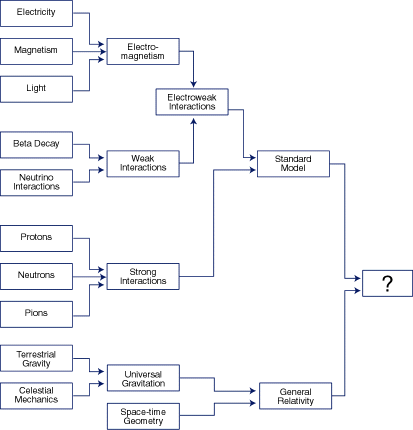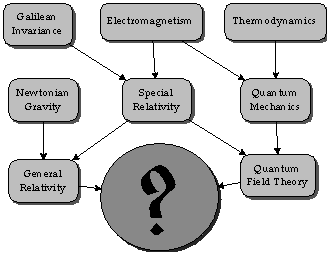

Unification of Forces
| Themodynamics | Quantum Mechanics |
The new feature that is required in a successful union of quantum mechanics and special relativity is the possibility of the creation and annihilation of quanta (or `particles'). The non-relativistic theory does not have this feature. The framework in which quantum mechanics and special relativity are successfully
reconciled is called quantum field theory. It is based on three basic
principles: two of them, of course, are quantum mechanics and special
relativity. The third one, which I wish to emphasize, is the postulate
that elementary particles are point-like objects of zero intrinsic size.
In practice, they are smeared over a region of space due to quantum effects,
but their descripton in the basic equations is as mathematical points.
|
|
| Electro-magnetism | |||
| Galilean Invariance | Special Relativity | ||
| General Relativity | |||
| Newtonian Gravity | Newtonian Gravity +SpaceTime Geometry |
| Electro-magnetism | Electroweak Interactions | An important advance in this quest was made in 1967-68 by the American physicist Steven Weinberg and the Pakistani physicist Abdus Salam. They succeeded in unifying the weak interaction and the electromagnetic interaction by using a mathematical technique known as gauge symmetry (see Elementary Particles). According to this theory the electromagnetic interaction consists of the exchange of a photon, and the weak interaction of the exchange of W and Z intermediate bosons. These bosons are believed to belong to the same family of particles as the photons. |
| Weak Interactions | ||
| Strong Interactions | Strong Interactions | |
| Gravitation | gravitational forces |
|
Standard Model
|
taken from http://www.sciam.com/1999/1299issue/1299weinberg.html The Standard Model is a quantum field theory. Its basic ingredients are fields, including the electric and magnetic fields of 19th-century electrodynamics. Little ripples in these fields carry energy and momentum from place to place, and quantum mechanics tells us that these ripples come in bundles, or quanta, that are recognized in the laboratory as elementary particles. For instance, the quantum of the electromagnetic field is a particle known as the photon. The Standard Model includes a field for each type of elementary particle that has been observed in high-energy physics laboratories [see the 'Standard Model' illustration below]. There are the lepton fields: their quanta include the familiar electrons, which make up the outer parts of ordinary atoms, similar heavier particles known as muons and tauons, and related electrically neutral particles known as neutrinos. There are fields for quarks of various types, some of which are bound together in the protons and neutrons that make up the nuclei of ordinary atoms. Forces between these particles are produced by the exchange of photons
and similar elementary particles: the W+,
W- and Z0 transmit the weak force, and eight species of gluon
produce the strong forces. These particles exhibit a wide variety of masses that follow no recognizable pattern, with the electron 350,000 times lighter than the heaviest quark, and neutrinos even lighter. The Standard Model has no mechanism that would account for any of these masses, unless we supplement it by adding additional fields, of a type known as scalar fields. The word "scalar" means that these fields do not carry a sense of direction, unlike the electric and magnetic fields and the other fields of the Standard Model. This opens up the possibility that these scalar fields can pervade all space without contradicting one of the best established principles of physics, that space looks the same in all directions. (In contrast, if, for example, there were a significant magnetic field everywhere in space, then we could identify a preferred direction by using an ordinary compass.) The interaction of the other fields of the Standard Model with the all-pervasive scalar fields is believed to give the particles of the Standard Model their masses. |
| General Relativity |